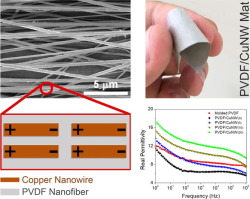当前位置:
X-MOL 学术
›
Eur. Polym. J.
›
论文详情
Our official English website, www.x-mol.net, welcomes your feedback! (Note: you will need to create a separate account there.)
Nanofibers of Poly(Vinylidene Fluoride)/Copper Nanowire: Microstructural Analysis and Dielectric Behavior
European Polymer Journal ( IF 6 ) Pub Date : 2018-04-01 , DOI: 10.1016/j.eurpolymj.2018.02.017 João Paulo Ferreira Santos , Aline Bruna da Silva , Mohammad Arjmand , Uttandaraman Sundararaj , Rosario Elida Suman Bretas
European Polymer Journal ( IF 6 ) Pub Date : 2018-04-01 , DOI: 10.1016/j.eurpolymj.2018.02.017 João Paulo Ferreira Santos , Aline Bruna da Silva , Mohammad Arjmand , Uttandaraman Sundararaj , Rosario Elida Suman Bretas

|
Abstract The combination of copper and dielectric materials have emerged as one of the most promising alternatives for the next generation of charge storage devices and microelectronic integrated circuits. In this work, copper nanowires (CuNW) were synthesized using a hard template technique, where copper was electrodeposited into and then liberated from porous alumina templates. Flexible nanofibers of poly(vinylidene fluoride)/copper nanowire (PVDF/CuNW) at different loadings were then obtained using the technique of electrospinning. SEM and TEM images showed that the CuNW had a straight, rigid structure with an average length and diameter of 1.5 µm and 30 nm, respectively. The morphological characterizations also revealed that the CuNW were embedded and aligned inside the nanofibers of PVDF, leading to an increase in the diameters of the generated electrospun nanofibers, e.g., 154 nm and 227 nm for pure PVDF and PVDF/CuNW (20 wt%), respectively. The polymorphic behavior of the PVDF/CuNW nanofibers was studied by FTIR and WAXD, confirming the positive impact of electrospinning on piezoelectric β phase formation of the PVDF matrix. Dielectric measurements indicated that the real permittivity of the mats of the nanofibers increased with CuNW loading. The ascending trend of the real permittivity with the filler content was ascribed to the formation of nanocapacitor structures, i.e., the copper conductive nanofillers acting as nanoelectrodes and the polymer matrix as nanodielectrics. Thus, the results of this study showed that the electrospun PVDF/CuNW nanofibers could be suitable in applications where flexible dielectric and piezoelectric materials are required.
中文翻译:

聚(偏二氟乙烯)/铜纳米线的纳米纤维:微观结构分析和介电行为
摘要 铜和介电材料的组合已成为下一代电荷存储设备和微电子集成电路最有前途的替代品之一。在这项工作中,铜纳米线 (CuNW) 是使用硬模板技术合成的,其中铜被电沉积到多孔氧化铝模板中,然后从多孔氧化铝模板中释放出来。然后使用静电纺丝技术获得了不同负载量的聚偏二氟乙烯/铜纳米线(PVDF/CuNW)的柔性纳米纤维。SEM 和 TEM 图像显示,CuNW 具有直的、刚性结构,平均长度和直径分别为 1.5 µm 和 30 nm。形态特征还表明,CuNW 嵌入并排列在 PVDF 的纳米纤维内,导致生成的电纺纳米纤维的直径增加,例如纯 PVDF 和 PVDF/CuNW(20 wt%)分别为 154 nm 和 227 nm。通过 FTIR 和 WAXD 研究了 PVDF/CuNW 纳米纤维的多晶型行为,证实了静电纺丝对 PVDF 基体的压电 β 相形成的积极影响。介电测量表明纳米纤维垫的实际介电常数随着 CuNW 负载的增加而增加。实际介电常数随填料含量的上升趋势归因于纳米电容器结构的形成,即铜导电纳米填料作为纳米电极,聚合物基体作为纳米电介质。因此,
更新日期:2018-04-01
中文翻译:

聚(偏二氟乙烯)/铜纳米线的纳米纤维:微观结构分析和介电行为
摘要 铜和介电材料的组合已成为下一代电荷存储设备和微电子集成电路最有前途的替代品之一。在这项工作中,铜纳米线 (CuNW) 是使用硬模板技术合成的,其中铜被电沉积到多孔氧化铝模板中,然后从多孔氧化铝模板中释放出来。然后使用静电纺丝技术获得了不同负载量的聚偏二氟乙烯/铜纳米线(PVDF/CuNW)的柔性纳米纤维。SEM 和 TEM 图像显示,CuNW 具有直的、刚性结构,平均长度和直径分别为 1.5 µm 和 30 nm。形态特征还表明,CuNW 嵌入并排列在 PVDF 的纳米纤维内,导致生成的电纺纳米纤维的直径增加,例如纯 PVDF 和 PVDF/CuNW(20 wt%)分别为 154 nm 和 227 nm。通过 FTIR 和 WAXD 研究了 PVDF/CuNW 纳米纤维的多晶型行为,证实了静电纺丝对 PVDF 基体的压电 β 相形成的积极影响。介电测量表明纳米纤维垫的实际介电常数随着 CuNW 负载的增加而增加。实际介电常数随填料含量的上升趋势归因于纳米电容器结构的形成,即铜导电纳米填料作为纳米电极,聚合物基体作为纳米电介质。因此,


























 京公网安备 11010802027423号
京公网安备 11010802027423号